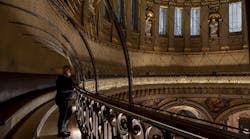Each year, LEDs Magazine editors review the top business stories, commercial developments, and technology updates that were most popular with our website visitors. While that 2023 top stories piece will land on our site in December, we thought we could avail ourselves of additional reports delivered by our colleagues within Endeavor Business Media to provide a holistic view of economic forces, technology trends, and activities that will impact the lighting sector as part of the architectural, engineering, and construction industry.
Sourced reports were written by staff and contributors to Architectural SSL, BUILDINGS, Contractor, Electrical Construction & Maintenance (EC&M), Microgrid Knowledge, and Smart Buildings Technology. Links are included to each original source below.
1. Changes in real estate utilization drive fresh demand for rejuvenated spaces.
When BOMA International president and CEO Henry Chamberlain delivered a June state-of-the-industry address on commercial real estate amid concerns over an economic recession, he observed that “CRE continues to be a diverse and challenging marketplace” recovering from lower building utilization rates during the global pandemic. Still, he revealed that a BOMA survey found a 200% increase in investment in amenities. BUILDINGS content director Robert Nieminen writes that “building owners and managers are making the necessary investments in their properties to attract and retain tenants in this challenging marketplace.” Furthermore, Chamberlain explained, revamped spaces were not all about recreation but encouraging collaboration and experiences that aren’t achieved while working from home.
Source: BUILDINGS, “Reason for Optimism: State of the CRE Industry (BOMA 2023),” June 28, 2023.
Environments LLC CEO Erin McDannald elaborated on the renewed attention to commercial space utilization and amenities in an interview with LEDs Magazine. Not only did Environments and its sister company, Lighting Environments, utilize its own people tracking and occupancy system to inform its office needs, the organization now offers a digital twin-based software solution that helps clients to evaluate and envision their workplace design, flow of activity or inventory, and discover new revenue opportunities in terms of real estate management.
2. Increased federal funding opportunities, energy rebates, and incentives will cause new construction as well as building retrofit growth spurts.
EC&M staff reported on Associated Builders and Contractors’ data in early November, observing that U.S. nonresidential construction spending increased by 0.3% in September, with publicly funded construction accounting for 72% of this increase in spending. ABC chief economist Anirban Basu said that “Given increased federal infrastructure spending and exorbitant financing costs for private construction, that dynamic should remain firmly in place over the coming months.”
Source: EC&M, “Nonresidential Construction Spending Increases for the 16th Straight Month in September,” Nov. 1, 2023.
Industry writer and Lighting Controls Association education director Craig DiLouie has updated lighting designers, building owners, and facilities managers regarding Inflation Reduction Act (IRA)–induced revisions to U.S. tax code that expanded the Commercial Buildings Tax Deduction (CBTD). The revisions outline per-square-foot incentives available for qualifying energy-efficient commercial buildings, evaluated against reference building criteria — for both new construction and retrofit projects. Coupled with the need to meet building code mandates designed to reach decarbonization goals, real estate developers and other commercial facilities managers could capitalize on energy incentives and rebates to improve their campuses while increasing the value of properties. DOE programs such as the L-Prize competition, the Integrated Lighting Campaign, and the Justice40 Initiative should continue to increase both awareness and adoption of robust, cleaner, and more energy-efficient technologies that are made accessible to all communities.
3. Electrification and renewable energy demands will drive building investments.
Contractor editor-in-chief Steve Spaulding was onto something when he wrote that the buzzword of 2023 was “electrification.” Spaulding tempered the push for electrification with a dose of reality, noting that in order to transition our 60% fossil-fuel-generated electricity to renewable energy sources by 2035, “capacity will need to grow by about 40% within roughly the same time frame to meet increased strain on the grid.” Still, he said, the aforementioned IRA and the Bipartisan Infrastructure Law ensure that financial resources are available to invest in our future needs. After all, Spaulding observed, “you don’t build capacity and then wait for demand to show up — you build capacity to meet demand.”
Source: Contractor, “The Electrification Roadmap,” April 3, 2023.
Furthermore, in recent reporting on federal funds in excess of $3 billion released for hundreds of new microgrid projects, Microgrid Knowledge managing editor Rod Walton wrote that nearly 35 GW of renewable energy would be made possible as a result of the investment. Walton cited the forecasts of multiple market research firms claiming the microgrid sector would triple in size over the decade from 2020 to 2030, and noted that military and healthcare facilities, data centers, and manufacturing sites were among those considered “mission critical locations for a localized layer of power reliability.”
Source: Microgrid Knowledge, “New Infrastructure Act Funding Release: DOE Allocates $3.5B toward Grid Resilience, Microgrids Nationwide,” Oct. 19, 2023.
Indeed, energy resiliency and grid localization were hot topics during the DOE’s second annual Justice Week program. As part of the checks and balances for the administration’s Justice40 Initiative, Justice Week delivers granular detail on capital investment and localized projects to which federal funds were distributed to ensure equitable access to stable and reliable power in historically underserved communities. Community leaders hailing from the Hawaiian Islands to the Gulf South to tribal lands summarized the challenges presented by outdated infrastructure in the face of climate-driven events such as drought, wildfires, and massive storms. Federal program representatives demonstrated the ways in which capital investment, administrative, and advisory resources helped to launch energy projects that could be sustainably managed by local authorities, providing a model for other communities to follow suit.
4. Attention to indoor experience will influence workplace occupancy, behavior, and productivity while achieving greener goals.
Early this year, Honeywell’s 2023 Building Occupant Survey Report revealed that commercial building occupants wanted employers, by and large, to address indoor air quality and carbon footprint concerns. According to editors at Smart Buildings Technology, 82% of respondents “said their expectations for improved IAQ have increased in the past three years” and many survey participants were unsure how often those responsible for facilities management monitored building IAQ, leaving room for improvement of both the air quality itself and the communication of metrics.
These sentiments were echoed in former senior editor Matt Vincent’s report on research by the Continental Automated Buildings Association (CABA) in partnership with Harbor Research. CABA board chair Brian Ensign stated that “the intelligent buildings sector has a stake in creating healthy buildings not only for people’s [wellbeing], but also to help owners and operators cost-effectively meet consumer demand, comply with evolving regulatory requirements, and respond to business needs such as reducing employee absenteeism.”
Sources: Smart Buildings Technology, “Honeywell issues 2023 Building Occupant Survey Report,” Feb. 23, 2023; and “CABA updates research on healthy buildings, indoor environmental quality,” May 16, 2023.
As a society, we probably didn’t need a pandemic to inform us that our buildings are typically not maximized to support health beyond providing an envelope that maintains heating and cooling conditions as needed. Still, as Pacific Northwest National Laboratory senior engineer Gabe Arnold wrote for LEDs, this year “the Centers for Disease Control and Prevention (CDC) announced guidelines recommending that buildings aim for 5 equivalent air changes per hour (eACH) of clean air to reduce airborne disease transmission. As a point of reference, many commercial buildings may have only 1-2 eACH of clean air ventilation.” How can the lighting and building industry help combat this problem without overtaxing the energy grid? By leveraging CDC and ASHRAE metrics that determined the combined capabilities of filtration and germicidal ultraviolet (GUV) equipment, Arnold divulged, researchers have found that an appropriately designed and maintained GUV system “can deliver 10 eACH or more at a lower cost than a major HVAC upgrade at a fraction of the energy consumption and carbon emissions of equivalent ventilation.” By the numbers, that strategy would address occupant concerns about IAQ while balancing the expense of equipment alongside energy efficiency.
It's been an interesting year — one that foretells an upswing in energy infrastructure and building construction/design activity that should in turn influence growth in the commercial and industrial lighting and controls sector, while broadening opportunities for innovation and expansion into partnership with other markets.
CARRIE MEADOWS is editor-in-chief of LEDs Magazine, with 20-plus years’ experience in business-to-business publishing across technology markets including solid-state technology manufacturing, fiberoptic communications, machine vision, lasers and photonics, and LEDs and lighting.
Follow our LinkedIn page for our latest news updates, contributed articles, and commentary, and our Facebook page for events announcements and more. You can also find us on the X platform.









